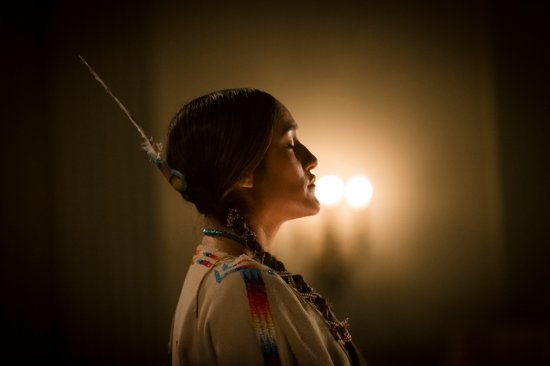
The actor and activist on playing indigenous roles, embracing her mixed heritage and loving Shirley Temple
When Q’orianka Kilcher was a budding actor of 6, an interviewer asked her what roles she dreamed of playing. She couldn’t decide between her two heroes, so she named them both: Pocahontas and Hawaiian Princess Ka‘iulani. By the time she was 19, she had played both.
At 27, Kilcher is adding another historical figure to her roster: storyteller and actor Mary Thompson Fisher, who became famous in the 1930s under the stage name Te Ata (Maori for “bearer of the morning”). A citizen of the Chickasaw Nation, her talents won her fans including President Franklin D. Roosevelt, who invited her to perform at his first state dinner. In the new film Te Ata, financed by the Chickasaw Nation, Kilcher portrays her as a passionate cultural ambassador at a time when it was illegal even to dance a traditional Native American dance.
[time-brightcove not-tgx=”true”]
Like the real-life Te Ata, who was half German, Kilcher is of mixed heritage: her mother is Swiss-Alaskan and her father Peruvian. But that’s not why Kilcher says she found a kindred spirit in the character. “What touched me most about Te Ata is not seeing your differences as a crutch,” she says, “but rather as an advantage.”
Early in her career, Te Ata attempted to find mainstream success, enduring countless Broadway auditions only to have doors slammed in a face that was never quite right for the part. It wasn’t until she leaned in to her heritage that she found fame. Similarly, Kilcher has built a career by embracing indigenous stories. It’s a path that has resulted in part from her desire to “highlight that part of American history people like to sweep under the rug.” But it also stems from the challenges of being an actor with indigenous roots in an industry in which difference is often exoticized but less frequently celebrated. “It’s been disheartening at times,” she says. “I’m never native enough, and I’m never white enough.”
To hear Kilcher describe her heritage is to envision a spinning globe: “I was born in Germany, raised in Hawaii, and my father is from Peru. I’m Quechua–Huachipaeri from the jungles and highlands of South America, and Swiss, Alaskan and French.” Or, as she puts it, “I’m a little mutt.” Kilcher was raised by her mother, a human-rights activist who speaks six languages. “I’m very proud of all of my roots,” she says, beaming, and launches into the story of her great-grandfather, a Swiss immigrant who was one of the first Alaskan homesteaders and who helped write the state’s constitution.
Growing up immersed in the arts, Kilcher idolized the Tejano pop star Selena (or at least, Jennifer Lopez’s portrayal of her in the 1997 biopic) and Shirley Temple. Kilcher’s first movie role was a Seussian Who in the 2000 adaptation of How the Grinch Stole Christmas, but she broke out five years later as a spirited Pocahontas in Terrence Malick’s The New World. That film coincided with her emergence as an activist. She recalls walking into the offices of Amnesty International, telling staffers she had a movie coming out and asking what issues she could help highlight. She was 15 years old. Since then, she has worked with grassroots youth organizations in Peru and around the world, focusing on environmental and human-rights issues.
Kilcher’s activism has informed the roles she takes. “I found when I was in Peru, there are a lot of young people that are ashamed to be indigenous,” she says. In portraying women like Te Ata, she sees an opportunity to inspire them to “embrace what makes them unique and be proud to be indigenous.”
Still, she hopes Hollywood is moving toward casting that’s “based more on your work as an actor than the color of your skin.” Kilcher just finished filming TNT’s series The Alienist, based on Caleb Carr’s 1994 novel. In the book, her character has blond hair and blue eyes. “When you’re working in Hollywood, there is always that thing of, ‘Oh, you can only go out for a native role,’” she says. “And they ended up casting me. I was just so grateful, because it’s not often that it happens.”
But her goal has never been to blend in. “The girl next door, it’s never really been my thing,” she says. “I’ll never be the girl that sells Cheerios to somebody. And you know what?” Kilcher flashes a megawatt smile. “I think it’s a great problem to have.”